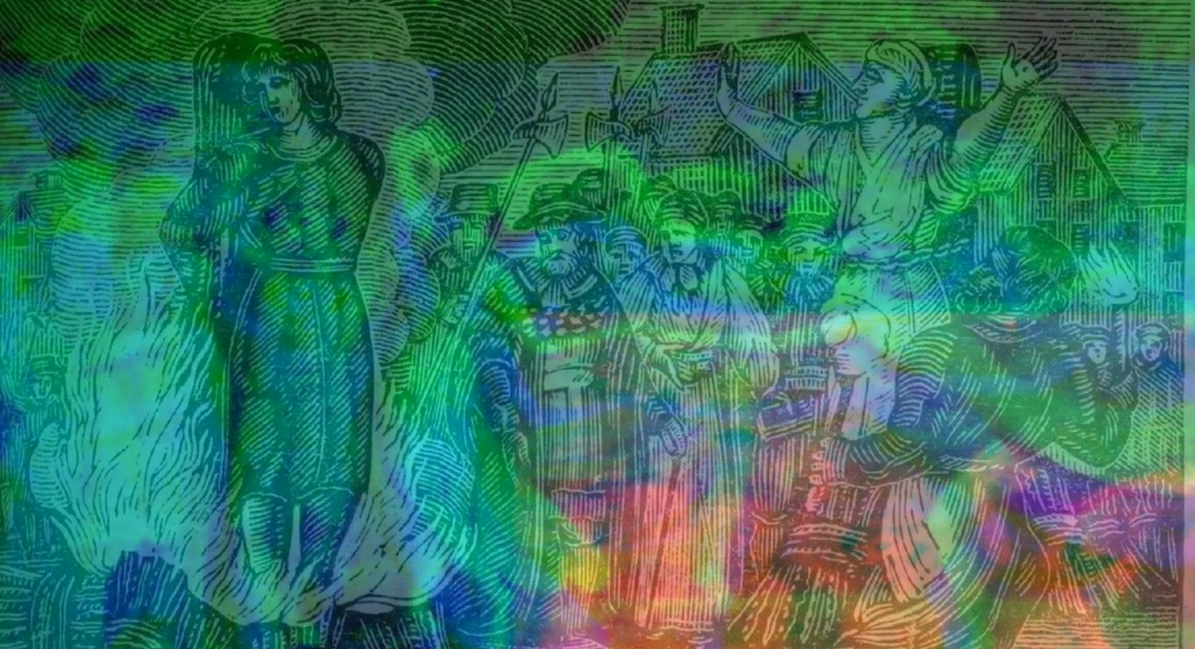In 1566 John Walsh of Dorset was accused of witchcraft.
He admitted being able to tell if a person was bewitched.
A gift bestowed upon him partly by fairies.
The fairies, he claimed, lived in great heaps of earth in Dorsetshire and could be consulted for one hour, at either noon or midnight.
Walsh also defined three kinds of fairies.
Green, white and black.
He went on to say the black was the worst.
Bessy Dunlop, a wise woman healer of Ayrshire, was accused of witchcraft and sorcery on November Eighth, 1576.
She suddenly became a successful herbalist and healer and gained second sight.
This helped her predict the recovery or death of patients and the location of lost objects.
In her trial, Dunlop testified that she had been taught these abilities by a phantom fairy named Thorne or Thome Reid.
Reid told her that he had been ordered to be her attendant by the Queen of Elfhane.
Many years before, when Dunlop was in childbirth, the Queen appeared before her as a stout woman, asked for a drink, and was given one.
Reid explained to Dunlop that afterward, he had been killed in the battle of Pinkie on September tenth, 1547, and had gone to Fairyland.
He now served the Queen of Elfhane.
The ghostly Reid appeared many times before Dunlop, beseeching her to go away with him to Fairyland or to deny the Christian faith.
In exchange for which he would grant her every wish.
She denied him repeatedly.
One day, Reid appeared with a company of eight women and four men.
Reid explained that they were “good wights” , fairies, who lived in Elfland.
They asked Dunlop to accompany them.
When Dunlop remained silent, they left “with a hideous ugly howling sound, like that of a hurricane.”
Reid continued to visit Dunlop, offering his assistance in healing sick animals and people.
Eventually, he gave her herbal ointments and taught her how to use them and predict their effectiveness.
Dunlop would see Reid in town from time to time, though he remained invisible to others.
He always appeared if she summoned him thrice.
On every occasion, he begged her to come with him to Fairyland.
Sometimes he would be tugging at her apron.
However, she always refused.
This sometimes put him in an ill humor.
These supernatural visits went on for four years before Dunlop was brought down on charges of witchcraft.
The fact that Dunlop had always used her new skills for good did not help her case.
Neither did her testimony that her benefactor was a fairy and not the Devil.
Dunlop was convicted and burned at the stake.
A few years later, in 1588, Alison Pearson of Byrehill was charged with invoking the spirits of the Devil.
She also was said to have a fairy familiar.
Her cousin, William Sympson, a physician had been kidnapped by a Gypsy and had died.
One day while Pearson was traveling, she felt ill and lay down.
A green man, as in Sympson appeared and said he would do her good if she would be faithful to him.
The green man vanished and reappeared with a band of fairies, who cajoled Pearson into accompanying them and taking part in their drinking and merrymaking.
Pearson gradually became comfortable with her fairy friends.
If she talked about their activities, however, she was tormented with blows that left insensitive spots on her skin.
Sympson advised her of when the fairies were coming to her and of the fact that they usually arrived in a whirlwind.
Sympson also taught her how to use herbal remedies and told her that every year, the Devil took one-tenth of the fairies away to hell as a tithe.
Like Dunlop, Pearson’s confession only worsened her case.
She also was convicted and burned.
Isobel Gowdie, Scotland’s renowned witch who voluntarily confessed in 1662, said she had frequent doings with fairies.
Gowdie went often to Fairyland, entering through various caverns and mounds.
The entrance of Fairyland was populated with elf-bulls, whose “roaring and skoilling” always frightened her.
She often met with the King and Queen of Fairy, who were finely dressed and offered her more meat than she could eat.
Gowdie, her fellow witches and the fairies would amuse themselves by A queen meets the Lion Fairy.
This was from the fairy tale “The Frog and the Lion Fairy” in Andrew Lang’s The
Orange Fairy Book.
Gowdie said the fairies manufactured their poisonous elf-arrow heads in their caverns.
She went on to say that she had seen the Devil working alongside them, putting the finishing touches on the flints.
Fairies taught her how to fly, by mounting cornstraws and beanstalks and crying, “Horse and Hattock, in the Devil’s name!”
As late as 1894 beliefs in fairies and witches in Ireland caused the murder of Bridget Cleary of Clonmel.
Bridget Cleary of Clonmel was accused by her own husband and family of being a changeling wife.
The trials of Michael Cleary and Bridget’s relatives were Ireland’s last involving witchcraft.

